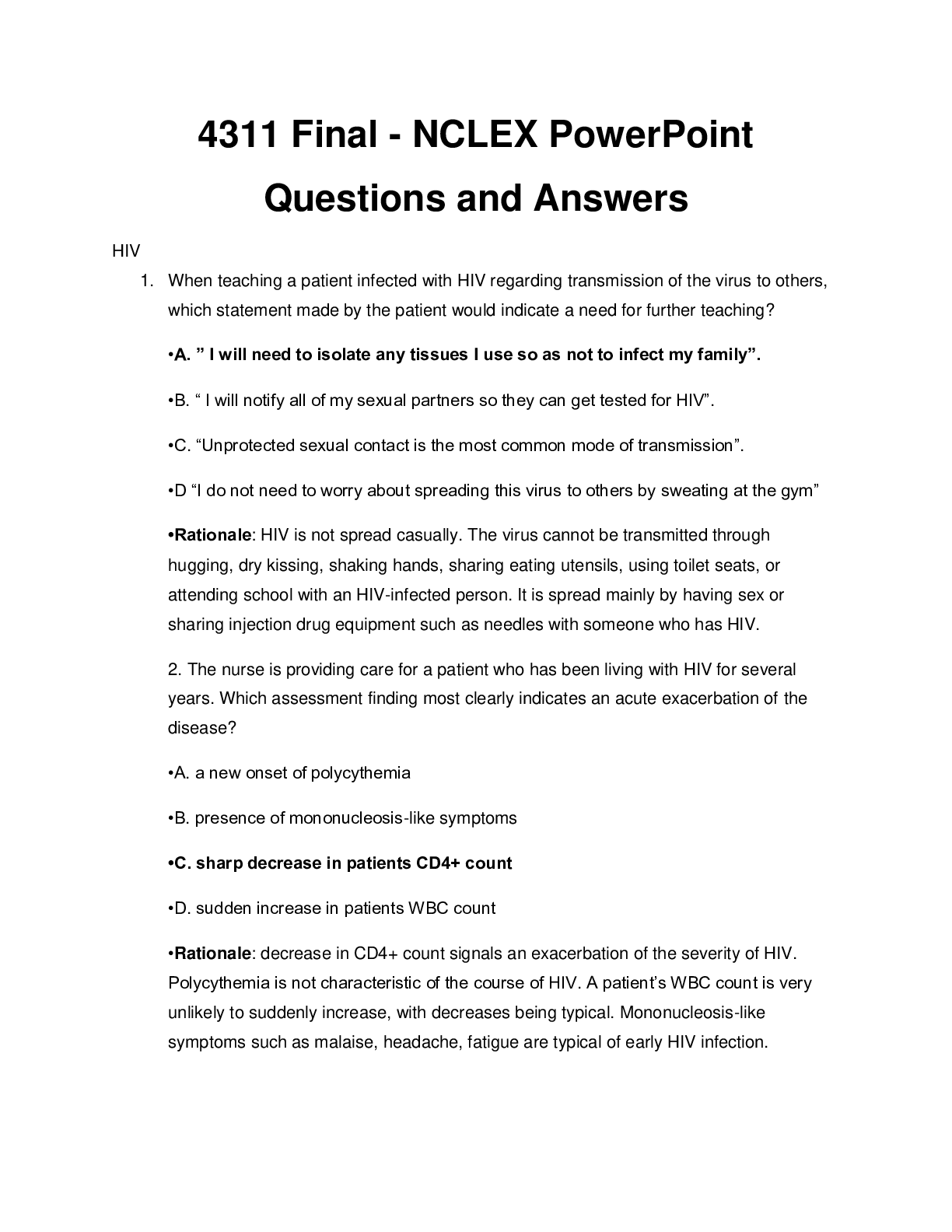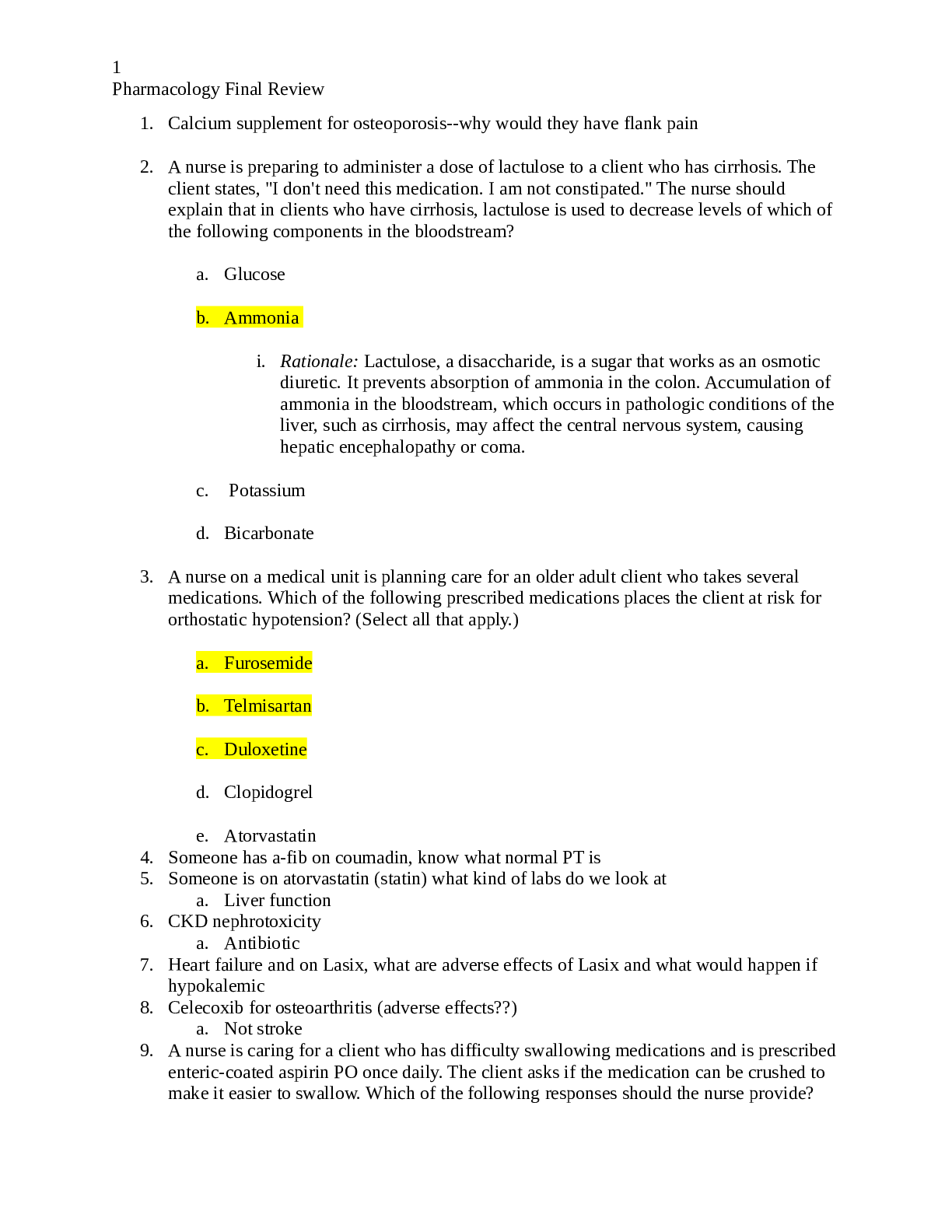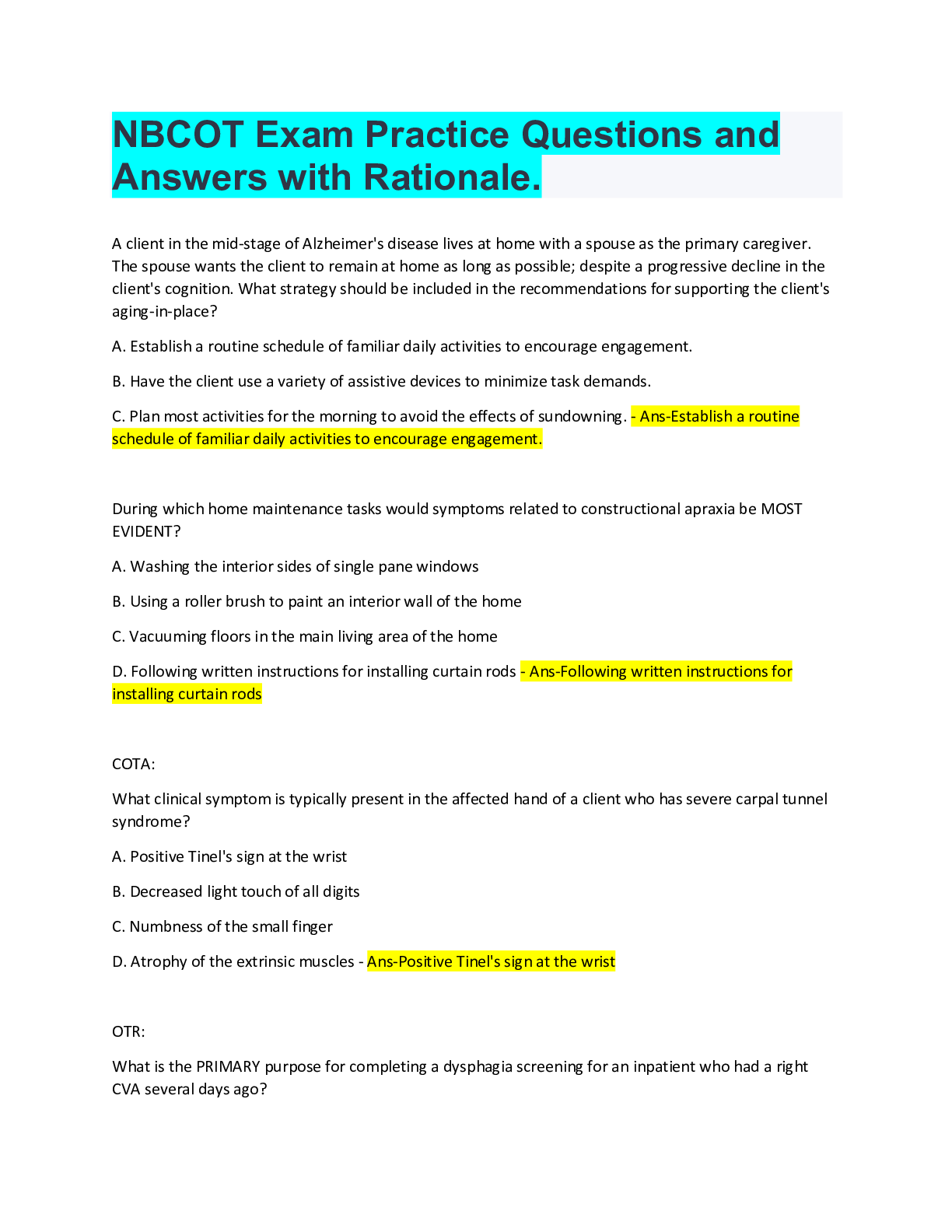*NURSING > QUESTIONS & ANSWERS > University of Perpetual Help System Laguna - DEPARTMENT 102Mental Health Disorders. Answers with Rat (All)
University of Perpetual Help System Laguna - DEPARTMENT 102Mental Health Disorders. Answers with Rationale. Exam Prep.
Document Content and Description Below
University of Perpetual Help System Laguna - DEPARTMENT 102Mental Health Disorders 1. A nurse is caring for a client exhibiting compulsive behaviors. The nurse concludes that the compulsive behavior ... usually incorporates the use of which defense mechanism? 2. A client is found to have a borderline personality disorder. What behavior does the nurse consider is most typical of these clients? 3. A client who uses ritualistic behavior taps other clients on the shoulders three times as part of the ritual. What does the nurse infer about this client? 4. A client with a recent history of binge eating and purging is admitted to the eating disorder unit with a diagnosis of bulimia nervosa. How does the nurse explain bulimia nervosa to the family? 5. A client experiencing nonspecific, excessive, unpleasant feelings of being worried concerning one's safety likely is experiencing which mental health disorder? 6. A client who has been found to have bipolar disorder, manic episode, has been sleeping very little and has not eaten in the 2 weeks preceding hospitalization. What does the nurse conclude is the frequent cause of feeding problems in the overactive client? 7. A young adolescent is found to have anorexia nervosa. What does the nurse understand probably precipitated the anorexia nervosa? 8. The nurse can identify the most commonly demonstrated comorbid disorders associated with generalized anxiety disorder (GAD) by assessing the client for which of the following? Select all that apply. 9. A client is admitted to the mental health hospital with the diagnosis of major depression. What is a common problem that clients experience with this diagnosis? 10. A nurse who plans to care for a client with an obsessive-compulsive disorder should understand that the client’s personality can usually be characterized in what way? 11. A nurse in the mental health clinic is counseling a client with the diagnosis of depression. During the counseling session the client says, "Things always seem the same. They never change." The nurse suspects that the client is feeling hopeless. For what indication of hopelessness should the nurse assess the client? 12. A client is admitted to the hospital with a diagnosis of depression. What clinical manifestations of depression does the nurse expect when assessing this client? 13. What is the greatest difficulty for nurses caring for the severely depressed client? 14. A student is anxious about an upcoming examination but is able to study intently and does not become distracted by a roommate's talking and loud music. What level of anxiety is demonstrated by the student's ability to shut out the distractions? 15. A nurse is caring for a client exhibiting compulsive behaviors. The nurse concludes that the compulsive behavior usually incorporates the use of which defense mechanism? 16. When caring for clients who are demonstrating manic behavior, the nurse must constantly reassess these clients' physical needs. What characteristic about these clients makes this particularly important? 17. A female accountant comes to the health clinic for a preemployment physical. During the health history the new employee frequently states, "I feel so nervous about starting this job." She is able to connect with her feelings, thoughts, and actions but constantly focuses her attention on starting the new job. What does the nurse determine that the client is exhibiting? 18. A nurse is teaching a client and family about the characteristics of dementia of the Alzheimer type. What physiologic characteristic should the nurse include 19. A client who is to begin a physical therapy regimen after orthopedic surgery expresses anxiety about starting this new therapy. Why does the nurse respond that some of this apprehension can be an asset? 20. The nurse is working with a client who has a diagnosis of borderline personality disorder. What personality traits should the nurse expect the client to exhibit? Select all that apply. A: ENGAGING MANIPULATIVE 21. The client repeatedly performs ritualistic behaviors throughout the day to limit anxious feelings. How does the nurse characterize these behaviors? 22. A nurse in a mental health unit of the emergency department of a hospital frequently cares for adolescents who attempt suicide. What is important for the nurse to remember about adolescent suicide behavior? 23. A teenager recently committed suicide, and grief counselors have been working with fellow students. What behaviors indicate to the school nurse that another student may be considering suicide? Select all that apply. 24. During a home visit to an older adult, the nurse observes a change in behavior and suspects delirium. The nurse assesses the client for one of several conditions that may have precipitated the delirium. Select all that apply. 25. A client who is on the third day of detoxification therapy becomes agitated and restless. What are the signs and symptoms that indicate impending alcohol withdrawal delirium? Select all that apply. 26. A nurse is assessing a client and attempting to distinguish between dementia and delirium. Which factors are unique to delirium? Select all that apply. 27. A 30-year-old female client asks the nurse to change her room, stating that she hates her roommate and can't stand to be in the same room with her. Just as she finishes speaking, her roommate enters and the client tells her she missed her and has been all over the unit looking for her. What does the nurse recognize the client to be using? 28. A nurse is assigned to care for a group of clients who have been found to have depression. Which clinical manifestations does the nurse anticipate? Select all that apply. 29. The nurse is admitting a client with a history of bipolar disorder. The nurse determines that the client is in the manic phase. Which signs and symptoms contribute to the nurse's conclusion? Select all that apply. 30. For what clinical manifestations should the nurse assess a client during the first few hours of the alcohol withdrawal? Select all that apply. [Show More]
Last updated: 2 years ago
Preview 1 out of 11 pages

Buy this document to get the full access instantly
Instant Download Access after purchase
Buy NowInstant download
We Accept:

Reviews( 0 )
$11.00
Can't find what you want? Try our AI powered Search
Document information
Connected school, study & course
About the document
Uploaded On
Apr 18, 2020
Number of pages
11
Written in
Additional information
This document has been written for:
Uploaded
Apr 18, 2020
Downloads
0
Views
153


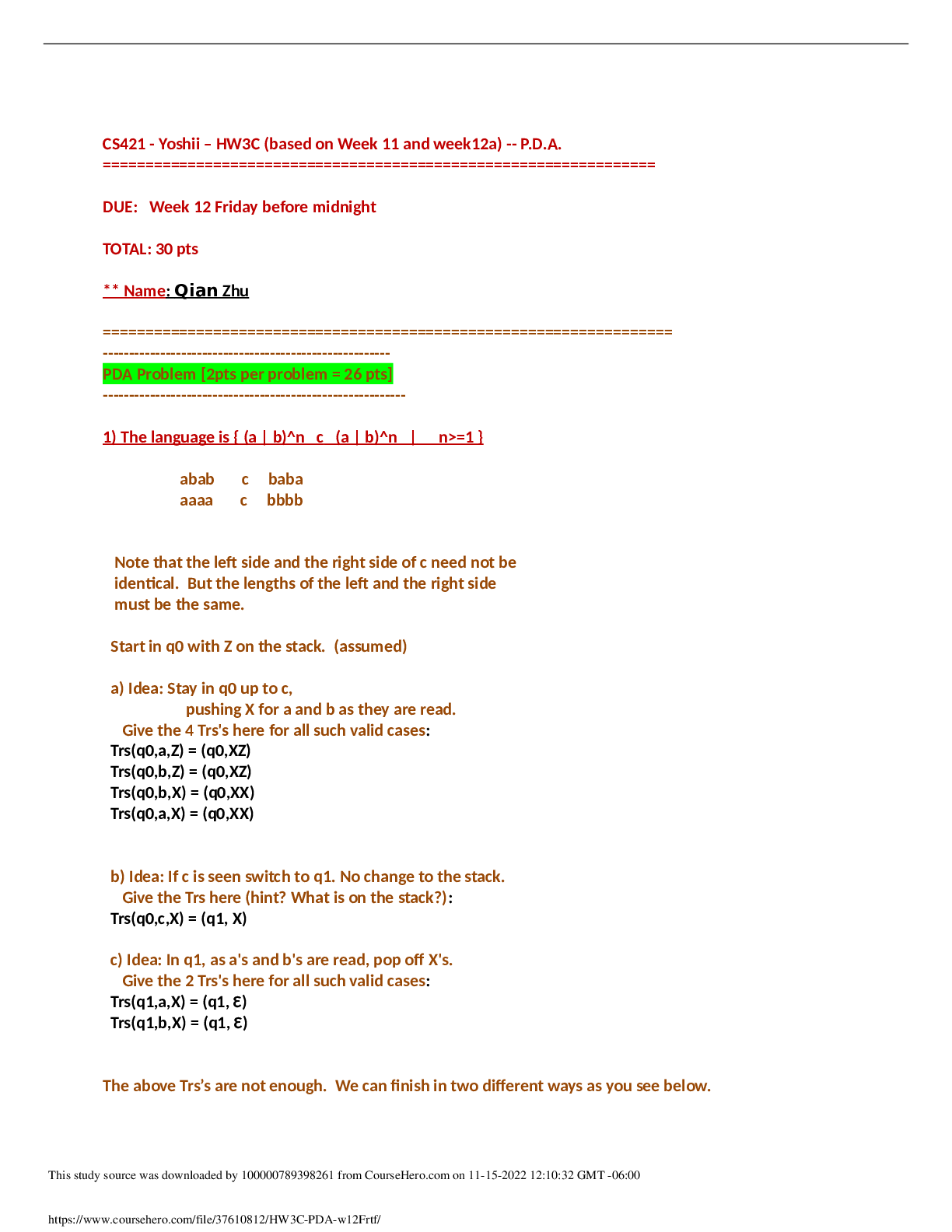


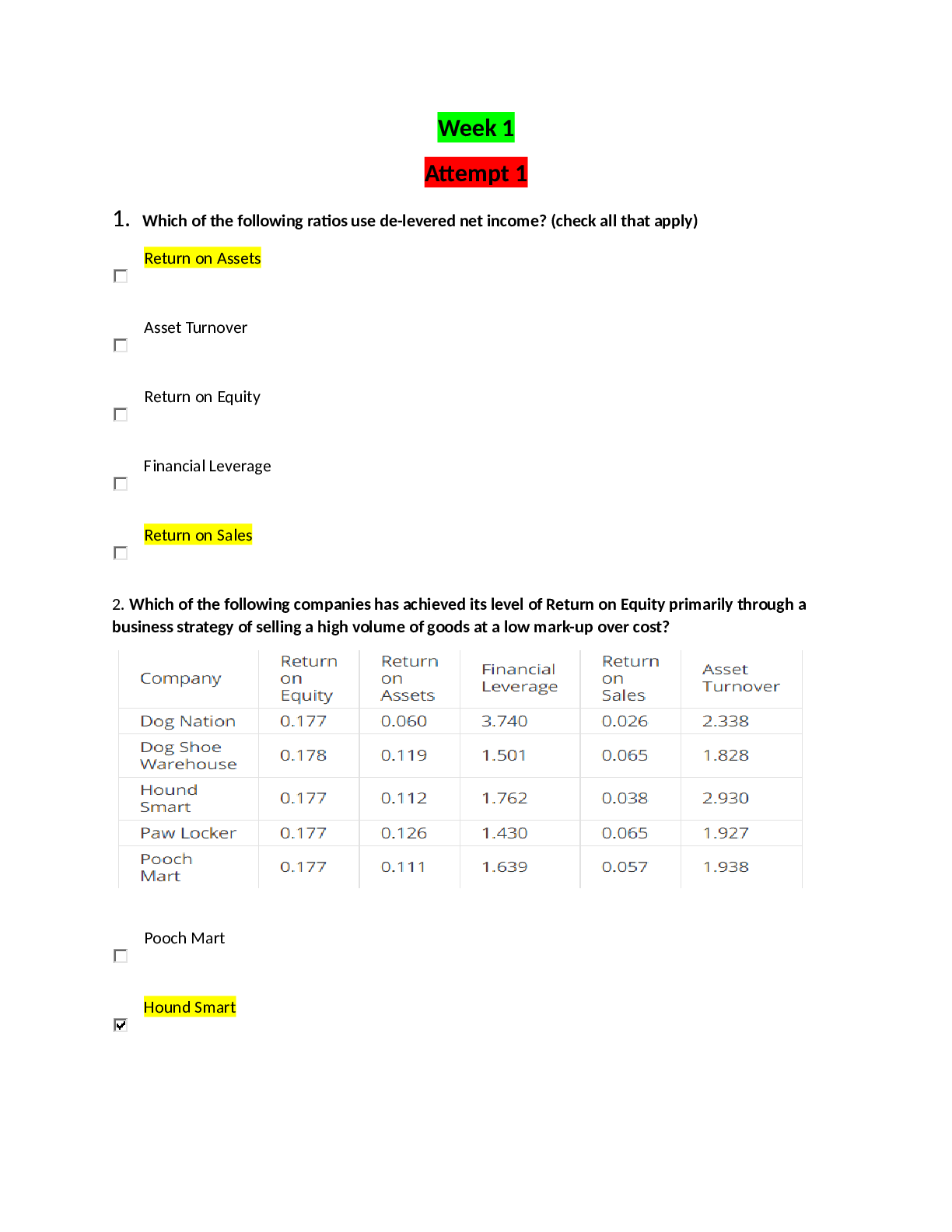
.png)
.png)
.png)
.png)
.png)
.png)
.png)
